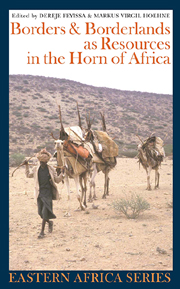Book contents
- Frontmatter
- Contents
- List of Maps, Tables & Charts
- Preface by Günther Schlee
- Editors' Preface
- Notes on Contributors
- List of Acronyms
- 1 State Borders & Borderlands as Resources
- 2 More State than the State?
- 3 Making Use of Kin beyond the International Border
- 4 The Tigrinnya-speakers across the Borders
- 5 Trans-Border Political Alliance in the Horn of Africa
- 6 People & Politics along & across the Somaliland-Puntland Border
- 7 The Ethiopian-British Somaliland Boundary
- 8 The Opportunistic Economies of the Kenya-Somali Borderland in Historical Perspective
- 9 Magendo & Survivalism
- 10 Can Boundaries not Border on One Another?
- 11 Conclusion
- Index
- EASTERN AFRICAN STUDIES
7 - The Ethiopian-British Somaliland Boundary
Published online by Cambridge University Press: 05 April 2013
- Frontmatter
- Contents
- List of Maps, Tables & Charts
- Preface by Günther Schlee
- Editors' Preface
- Notes on Contributors
- List of Acronyms
- 1 State Borders & Borderlands as Resources
- 2 More State than the State?
- 3 Making Use of Kin beyond the International Border
- 4 The Tigrinnya-speakers across the Borders
- 5 Trans-Border Political Alliance in the Horn of Africa
- 6 People & Politics along & across the Somaliland-Puntland Border
- 7 The Ethiopian-British Somaliland Boundary
- 8 The Opportunistic Economies of the Kenya-Somali Borderland in Historical Perspective
- 9 Magendo & Survivalism
- 10 Can Boundaries not Border on One Another?
- 11 Conclusion
- Index
- EASTERN AFRICAN STUDIES
Summary
Introduction
This chapter examines the history of the Ethiopian-(colonial) British Somaliland border, through the lens of local society. It is clear that the territorial claims and administrative ambitions of the respective governments provided both problems and opportunities for borderland Somali subjects. In the British Colonial Office archives the local Somalis are portrayed as the victims of Ethiopian manipulation, but the colonial voice does not allow for the Somalis’ astute manipulation of the border in their individual, local and group interests. Yet careful reading of British Foreign Office records detailing events at the eastern Ethiopian periphery, reveals various repertoires employed by the trans-border Somali communities and the affordances of state boundaries in the first half of the twentieth century.
The background
The borderland area dividing the Somali-inhabited territory of northeast Africa has a complex administrative history. Large parts of the northwestern Somali peninsula were claimed as part of the British Somaliland Protectorate. The Ethiopian victory at Adwa in 1896 and Ethiopia's effective occupation of large tracts of Somali-inhabited areas at its eastern periphery, forced the British to relinquish their original territorial claims in 1897 (Marcus 1965). The British colonial administration in Somaliland, along with many of its Somali subjects, bitterly regretted this cession. In fact, shortly after the British government reduced its territorial claims, the administration of what became the British Somaliland Protectorate desperately sought a solution that would reintegrate the lost areas back into the Protectorate territory (Silberman 1961; Drysdale 1964).
- Type
- Chapter
- Information
- Borders and Borderlands as Resources in the Horn of Africa , pp. 122 - 132Publisher: Boydell & BrewerPrint publication year: 2010



